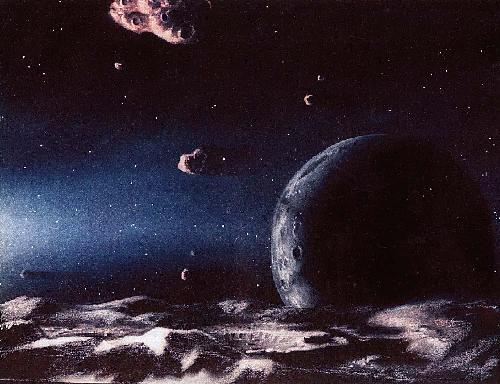 |
 |
|
| Comet | Jewitt | Kuiper |
|---|
| From Kuiper Belt To Comet |
|---|
Introduction
In the old view, the nuclei of comets were thought to be nearly
primordial objects, planetesimals from the accretion disk of the
sun. This view may still apply, with small modifications, to the
nuclei of long period comets (i.e. those having been stored
in the Oort Cloud). The nuclei of most short-period comets,
however, are now thought to be produced collisionally in the
Kuiper Belt. They are fragments of "parent" KBOs chipped off
by mutual collisions in the Kuiper Belt.
This new view is interesting because it allows the possibility that the material in the short-period nuclei might have been modified from its primordial mix. It could have been cooked by intrinsic heating in the larger KBOs. It could have been shocked and altered by the collision responsible for creating the small nucleus fragment out of the parent KBO. Maybe these nuclei are not so pristine after all?
I have examined this issue using two types of observations:
Color Evolution
If the short-period nuclei are fragments of KBOs, then it might be
expected that the nuclei and KBOs should have the same gross compositions.
We cannot yet measure compositions, so I used their colors as a proxy.
An introduction to this work is given here.
The full paper is linked here as a PDF file.
Shape Evolution
Another expectation from the collisional model is that the shapes
of the cometary nuclei should be like those of impact-produced fragments,
because that's exactly what the nuclei are now supposed to be. We cannot
measure the full 3D shape but we can infer a projection of the shape
from the rotational lightcurve (the time dependent brightness of a
rotating, aspherical body).
An introduction to this work is given here.
The full paper is linked here as a PDF file.
Last updated Aug 2009
 |
 |
|
| Comet | Jewitt | Kuiper |
|---|